1/27/08
Gardens That Work
Every January, the San Francisco Botanical Garden co-sponsors a two-day design symposium with Horticulture Magazine. I attended Day Two of this year's symposium, Gardens That Work, described thusly in the Botanical Garden's course catalog:
Unfortunately, the lights were kept very low which made it nearly impossible to take any notes. I should have insisted they be turned up, but I did not detect much support for that idea.
My only other criticism--why not get it out of the way--was a prominent local arborist--we'll call him Head Tripping--who, judging by his frequent, obnoxious interjections, must have thought he was at a CalHort meeting. I wanted to blow spitballs at the back of his head but I doubt that would have made him shut up. At any rate, he volunteered for duty on the projectors which he performed competently (for the most part).
Now then...
Bartley went first. A landscape architect based in Columbus, Ohio, she went to Europe and studied potagers, or kitchen gardens, which found their highest expression in French monasteries. Even if she hadn't told us, I would have recognized Bartley as an architect from her crisp and engaging academic rigor. What can I say...I enjoy architects. And I see she's been blogging now and then since April.
Under Henry VIII, England destroyed its monasteries and subsequent English landscape traditions devalued working gardens. Bartley noted the results were disastrous for English cuisine. Happily, things went differently in France. Bartley explained how the monastic potager, surrounded by high walls and hedges, can serve as a design template for small urban gardens in cities like San Francisco.
She advocated "stacking functions" (i.e., using plants that serve many purposes such as calendula--cut flower, edible, medicinal), bringing children in to the garden (her nieces have tea parties in her potager), and year-round planting. In California, especially on the coast, there is no excuse for not planting all year. Even in Ohio, Bartley plants garlic in the fall and harvests it in the snow. She showed us pictures to prove it.
She gave us slide tours of several Loire Valley monastic-style gardens including Prieure d'Orsan, Bois Richeux, Chateau Saint Jean de Beauregard, Potager du Roi, and Chateau de Villandry which she called the most famous vegetable garden in the world. Not content with France, she also gave props to Texas garden-blogger favorite, Antique Rose Emporium there in Brenham.
([In]sincere regrets for being lazy with accent marks.)
Until now, I've been tolerant of people who say that vegetable gardening "isn't pretty" even though I disagree. But after seeing Bartely's pictures today, I see no reason for tolerance. People who say vegetable gardening "isn't pretty" don't know what the eff they're talking about and should be disregarded.
And if Bartley's pictures weren't enough to convince me of that, Margaret Koski-Kent's pictures of McEvoy Ranch certainly were. Even for someone like me who knows nothing but California gardens, I found it hard to keep my jaw off the floor during her presentation. McEvoy Ranch, 550 acres in Petaluma an hour north of San Francisco, broke with wine country tradition by growing Tuscan olive trees (dozens of varieties, but mainly eight) and "over 800 combined varieties of flowers, vegetables, and fruit trees". They've been on my radar for a few years since I met one of their gardeners in my Plant I.D. class. Garden and orchard tours are available by reservation beginning in March, but I haven't visited there yet.
Typically Californian, Koski-Kent advocated away from the rigid structure of the formal garden and emphasized a naturalistic style. She said not enough designers are capable of working with a naturalist's palette. And she wasn't talking natives because I didn't see any natives in her slides besides wildflowers in the spring garden and some oaks in the distance. There were over 200 slides and I took very few notes.
Walls and enclosures were an important part of Bartley's potager talk. Koski-Kent joined that with her 7-foot-tall walls of Tithonia rotundifolia, Asteraceae. Sunset Western Garden says it's good in all zones, needs full sun and regular water. Perennial, grown as an annual. "Native from Mexico to Central America. Husky, rather coarse plant with velvety green leaves, spectacular gaudy flowers. Grows rapidly to 6' by 4'. Blooms from summer to frost, bearing 3-4-in.-wide blossoms with orange-scarlet rays and tufted yellow centers. Use as a temporary screen in summer. Hollow stems. Sow seed in place in spring. Tolerates intense heat, some drought. Attractive to butterflies, hummingbirds."
She grows several flowers just for their names. About Love In A Mist she said, "Love is almost always in a mist."
She's a fan of Snail Vine, Vigna caracalla syn. Phaseolus caracalla sometimes sold as Phaseolus gigantea. Perennial in Sunset zones 12-24, H1, H2, annual everywhere else. Full sun, regular water. Intensely fragrant.
She said Magda squash is everyone's favorite at McEvoy, and the head chef Gerald Gass doesn't want her to grow anything else.
Koski-Kent grows mushrooms, and during the Q&A after her talk, that's all anyone wanted to talk about. There were at least five questions about mushrooms. She basically said her source is Fungi Perfecti in Olympia, WA and left it at that. I'm impressed with them just for having that URL. Master of Ceremonies Fred Bove mentioned the book Mycelium Running as essential reading on the subject of fungi.
We broke for lunch and after that the Botanical Garden's curator Don Mahoney spoke. Dr. Mahoney has an extensive fan club at the Botanical Garden and beyond; I number myself among his adherents. When I took Betsy Clebsch's salvias class last year, Don came up in discussion and Ms. Clebsch interrupted herself to rave about him for several minutes.
When he started gardening, he said his goal was to have 1/3 natives, 1/3 butterfly plants, and 1/3 food. Again, I didn't take very many notes, but he showed us pictures of anise swallowtail, tortoiseshell, gulf frittilary, and buckeye butterflies (and respective larvae). He gave a ringing endorsement of Buddleija salvifolia for butterflies, but said his best habitat plant of all is a Montanoa.
Montanoas are 20-ft.-tall, fragrant, frost-sensitive asters from the meso-American cloud forests. I doubt very many are grown in the North America outside the Bay Area. Even here, they are very uncommon. SF Botanical Garden has several and I think UC Berkeley has some. There's one in a protected courtyard in downtown Sonoma, and there should be some in southern California. Sunset Western Garden doesn't mention the genus at all, and Botanica gives three species a light treatment.
Don advocates the layered treatment, and from his slides I think he's taken that to the next level in his garden. Suggestions from his course handout: "Winter-blooming tall salvias can fill in under deciduous trees. Under an apple tree, they can be cut low in the spring and then be allowed to extend and bloom in the fall. Hummingbirds love them. Or plant lettuce, arugula, and miners lettuce in your tomato patch. Leave some to go to seed and they will self sow to give you abundant winter greens after the tomatoes are finished and the winter rains start to fall. With luck, this will happen year after year." (I'm collecting suggestions for vegetable companions. Pam Peirce recommends starting pea vines in your corn patch when the corn stalks are 18" tall.)
Besides salvias, Don grows Dahlia imperialis under his apple trees. He keeps the tree dahlias short until the apples drop their leaves. The structural framework of the apple tree branches keep the tree dahlias from blowing over in winter storms. He didn't lose a single stalk in the storm two weeks ago that defoliated my Brugmansia (R.I.P.) and tattered my Bartlettina.
Don doesn't cut back anything unless he sees a compelling reason to do so, e.g. new growth. So when a deciduous perennial goes to sleep, the dormant material provides cover for birds during storms and habitat for overwintering larvae. For slugs, he has chickens. And turtles and toads.
He spouted off several suggestions, and I can't include them all but my favorite was to grow gourds as ground cover. I'm laughing right now as I type this.
After Don, Linda Beutler had the difficult task of closing this year's symposium. Difficult, not least because the previous three speakers had already fried my brain with plants and flowers and garden ideas. Beutler told us right off the bat she's a woman of strong opinions, so I knew immediately that I loved her. Note to public speakers: Even when I'm tired, I find it easier to listen to someone talk when strong opinions buoy their rhetoric. Let me know you've got 'em, and keep 'em coming.
Beutler teaches in the horticulture department at Clackamas County College in Oregon and she wrote the book Garden to Vase: Growing and Using Your Own Cut Flowers. She says florists are not taken seriously in the world of horticulture. Like mushrooms, they're kept in the dark and covered with shit. Ha! I don't know much about floristry, and it did seem to me like there was a big, invisible wall between the horticulture and floristry classes at City College of San Francisco. Beutler seemed more fluent in the language of horticulture than most gardeners I know and as certainly as knowledgeable as many of my horticulture instructors.
Some interesting foliage plants Beutler recommended for cutting gardens: a variegated corn Zea mays 'Tricolor' (good luck finding it), totally fuzzy Ballota pseudodictamnus (I think she said the minor flowers fall away and leave behind calyces that looks like hollyhocks), all grassy elements make arrangements look garden-y (a good thing).
She said wholesalers are bringing in dynamic new hybrids of Hypericum, but they won't tell anyone the cultivar names ("Don't get me started!"). Hypericum 'Elstead' produces two crops of bold berries that are good for arrangements.
She grows leeks in two beds--one for eating, and one just for flowers and her leek flowers were huuuge--Allium porrum 'St. Victor', perhaps. Dark lecture hall, bad notes! All pollinators visit leeks, she said.
She wants people to re-think roses. With 30,000 roses currently in the trade, there is no reason to ever plant a rose that needs spraying. She mentioned a fragrant green rose (Viridifolia?) that's very popular in Hawaii for leis that she can't get anyone excited about. And she showed us what a bouquet of roses should look like. I hope that picture's in her book, because I won't be able to describe it for you. Suffice it to say, it's not the upright, long-stemmed affair you get at the grocery store where the roses don't touch each other. Her ideal bouquet was rather dense and compact, with some roses lilting downward and no imperative for perfect foliage. She loved Helen Dillon's dark red + red arrangement of Moss rose 'William Lobb' with Lathyrus odoratus 'Beaujolais' at a party last year. (Helen Dillon spoke at the Botanical Garden during the first day of the symposium, along with the head gardener at Prince Charles' place--unfortunately, I had another engagement.)
Don't be a snob about chrysanthemums. Double-flowering Cosmos 'Psyche' lasts longer than single varieties in arrangements. You can't have too many containers and vases--experiment with anything that holds water or can be made to. She thanked Martha Stewart for bringing back hydrangeas. Use whole branches of fuchsia in arrangements. Put cut tulips in large volumes of water because cells all up and down the stem can take in water. She's wary of current trends in flower arrangement that use the meniscus line as a design element.
Okay!
This blog post must come to an abrupt end.
The blogger is beat.
Flowering herb knots, productive potagers, home orchards ripe with fruit – these are some of the joys of gardens that function as more than superbly designed and meticulously maintained spaces. These are gardens that pay back hard work with fresh food, cut flowers and sustained enjoyment.
The trend in garden design has been focused on these workhorse gardens for some time, but beautifully executed gardens that produce for our vases and tables are classics that will always be in fashion.
Join us for an exciting and inspiring day working through the design principles and horticultural techniques as well as sharing in some of the delights of beautiful, bountiful gardens that work.
Our speaker line-up features Jennifer Bartley, author of Designing the New Kitchen Garden, SFBGS Curator and "workhorse garden" expert Don Mahoney, and McEvoy Ranch Head Gardener Margaret Koski-Kent. Rounding out the day will be Garden to Vase author Linda Beutler.
Unfortunately, the lights were kept very low which made it nearly impossible to take any notes. I should have insisted they be turned up, but I did not detect much support for that idea.
My only other criticism--why not get it out of the way--was a prominent local arborist--we'll call him Head Tripping--who, judging by his frequent, obnoxious interjections, must have thought he was at a CalHort meeting. I wanted to blow spitballs at the back of his head but I doubt that would have made him shut up. At any rate, he volunteered for duty on the projectors which he performed competently (for the most part).
Now then...
Bartley went first. A landscape architect based in Columbus, Ohio, she went to Europe and studied potagers, or kitchen gardens, which found their highest expression in French monasteries. Even if she hadn't told us, I would have recognized Bartley as an architect from her crisp and engaging academic rigor. What can I say...I enjoy architects. And I see she's been blogging now and then since April.
Under Henry VIII, England destroyed its monasteries and subsequent English landscape traditions devalued working gardens. Bartley noted the results were disastrous for English cuisine. Happily, things went differently in France. Bartley explained how the monastic potager, surrounded by high walls and hedges, can serve as a design template for small urban gardens in cities like San Francisco.
She advocated "stacking functions" (i.e., using plants that serve many purposes such as calendula--cut flower, edible, medicinal), bringing children in to the garden (her nieces have tea parties in her potager), and year-round planting. In California, especially on the coast, there is no excuse for not planting all year. Even in Ohio, Bartley plants garlic in the fall and harvests it in the snow. She showed us pictures to prove it.
She gave us slide tours of several Loire Valley monastic-style gardens including Prieure d'Orsan, Bois Richeux, Chateau Saint Jean de Beauregard, Potager du Roi, and Chateau de Villandry which she called the most famous vegetable garden in the world. Not content with France, she also gave props to Texas garden-blogger favorite, Antique Rose Emporium there in Brenham.
([In]sincere regrets for being lazy with accent marks.)
Until now, I've been tolerant of people who say that vegetable gardening "isn't pretty" even though I disagree. But after seeing Bartely's pictures today, I see no reason for tolerance. People who say vegetable gardening "isn't pretty" don't know what the eff they're talking about and should be disregarded.
And if Bartley's pictures weren't enough to convince me of that, Margaret Koski-Kent's pictures of McEvoy Ranch certainly were. Even for someone like me who knows nothing but California gardens, I found it hard to keep my jaw off the floor during her presentation. McEvoy Ranch, 550 acres in Petaluma an hour north of San Francisco, broke with wine country tradition by growing Tuscan olive trees (dozens of varieties, but mainly eight) and "over 800 combined varieties of flowers, vegetables, and fruit trees". They've been on my radar for a few years since I met one of their gardeners in my Plant I.D. class. Garden and orchard tours are available by reservation beginning in March, but I haven't visited there yet.
Typically Californian, Koski-Kent advocated away from the rigid structure of the formal garden and emphasized a naturalistic style. She said not enough designers are capable of working with a naturalist's palette. And she wasn't talking natives because I didn't see any natives in her slides besides wildflowers in the spring garden and some oaks in the distance. There were over 200 slides and I took very few notes.
Walls and enclosures were an important part of Bartley's potager talk. Koski-Kent joined that with her 7-foot-tall walls of Tithonia rotundifolia, Asteraceae. Sunset Western Garden says it's good in all zones, needs full sun and regular water. Perennial, grown as an annual. "Native from Mexico to Central America. Husky, rather coarse plant with velvety green leaves, spectacular gaudy flowers. Grows rapidly to 6' by 4'. Blooms from summer to frost, bearing 3-4-in.-wide blossoms with orange-scarlet rays and tufted yellow centers. Use as a temporary screen in summer. Hollow stems. Sow seed in place in spring. Tolerates intense heat, some drought. Attractive to butterflies, hummingbirds."
She grows several flowers just for their names. About Love In A Mist she said, "Love is almost always in a mist."
She's a fan of Snail Vine, Vigna caracalla syn. Phaseolus caracalla sometimes sold as Phaseolus gigantea. Perennial in Sunset zones 12-24, H1, H2, annual everywhere else. Full sun, regular water. Intensely fragrant.
She said Magda squash is everyone's favorite at McEvoy, and the head chef Gerald Gass doesn't want her to grow anything else.
Koski-Kent grows mushrooms, and during the Q&A after her talk, that's all anyone wanted to talk about. There were at least five questions about mushrooms. She basically said her source is Fungi Perfecti in Olympia, WA and left it at that. I'm impressed with them just for having that URL. Master of Ceremonies Fred Bove mentioned the book Mycelium Running as essential reading on the subject of fungi.
We broke for lunch and after that the Botanical Garden's curator Don Mahoney spoke. Dr. Mahoney has an extensive fan club at the Botanical Garden and beyond; I number myself among his adherents. When I took Betsy Clebsch's salvias class last year, Don came up in discussion and Ms. Clebsch interrupted herself to rave about him for several minutes.
When he started gardening, he said his goal was to have 1/3 natives, 1/3 butterfly plants, and 1/3 food. Again, I didn't take very many notes, but he showed us pictures of anise swallowtail, tortoiseshell, gulf frittilary, and buckeye butterflies (and respective larvae). He gave a ringing endorsement of Buddleija salvifolia for butterflies, but said his best habitat plant of all is a Montanoa.
Montanoas are 20-ft.-tall, fragrant, frost-sensitive asters from the meso-American cloud forests. I doubt very many are grown in the North America outside the Bay Area. Even here, they are very uncommon. SF Botanical Garden has several and I think UC Berkeley has some. There's one in a protected courtyard in downtown Sonoma, and there should be some in southern California. Sunset Western Garden doesn't mention the genus at all, and Botanica gives three species a light treatment.
Don advocates the layered treatment, and from his slides I think he's taken that to the next level in his garden. Suggestions from his course handout: "Winter-blooming tall salvias can fill in under deciduous trees. Under an apple tree, they can be cut low in the spring and then be allowed to extend and bloom in the fall. Hummingbirds love them. Or plant lettuce, arugula, and miners lettuce in your tomato patch. Leave some to go to seed and they will self sow to give you abundant winter greens after the tomatoes are finished and the winter rains start to fall. With luck, this will happen year after year." (I'm collecting suggestions for vegetable companions. Pam Peirce recommends starting pea vines in your corn patch when the corn stalks are 18" tall.)
Besides salvias, Don grows Dahlia imperialis under his apple trees. He keeps the tree dahlias short until the apples drop their leaves. The structural framework of the apple tree branches keep the tree dahlias from blowing over in winter storms. He didn't lose a single stalk in the storm two weeks ago that defoliated my Brugmansia (R.I.P.) and tattered my Bartlettina.
Don doesn't cut back anything unless he sees a compelling reason to do so, e.g. new growth. So when a deciduous perennial goes to sleep, the dormant material provides cover for birds during storms and habitat for overwintering larvae. For slugs, he has chickens. And turtles and toads.
He spouted off several suggestions, and I can't include them all but my favorite was to grow gourds as ground cover. I'm laughing right now as I type this.
After Don, Linda Beutler had the difficult task of closing this year's symposium. Difficult, not least because the previous three speakers had already fried my brain with plants and flowers and garden ideas. Beutler told us right off the bat she's a woman of strong opinions, so I knew immediately that I loved her. Note to public speakers: Even when I'm tired, I find it easier to listen to someone talk when strong opinions buoy their rhetoric. Let me know you've got 'em, and keep 'em coming.
Beutler teaches in the horticulture department at Clackamas County College in Oregon and she wrote the book Garden to Vase: Growing and Using Your Own Cut Flowers. She says florists are not taken seriously in the world of horticulture. Like mushrooms, they're kept in the dark and covered with shit. Ha! I don't know much about floristry, and it did seem to me like there was a big, invisible wall between the horticulture and floristry classes at City College of San Francisco. Beutler seemed more fluent in the language of horticulture than most gardeners I know and as certainly as knowledgeable as many of my horticulture instructors.
Some interesting foliage plants Beutler recommended for cutting gardens: a variegated corn Zea mays 'Tricolor' (good luck finding it), totally fuzzy Ballota pseudodictamnus (I think she said the minor flowers fall away and leave behind calyces that looks like hollyhocks), all grassy elements make arrangements look garden-y (a good thing).
She said wholesalers are bringing in dynamic new hybrids of Hypericum, but they won't tell anyone the cultivar names ("Don't get me started!"). Hypericum 'Elstead' produces two crops of bold berries that are good for arrangements.
She grows leeks in two beds--one for eating, and one just for flowers and her leek flowers were huuuge--Allium porrum 'St. Victor', perhaps. Dark lecture hall, bad notes! All pollinators visit leeks, she said.
She wants people to re-think roses. With 30,000 roses currently in the trade, there is no reason to ever plant a rose that needs spraying. She mentioned a fragrant green rose (Viridifolia?) that's very popular in Hawaii for leis that she can't get anyone excited about. And she showed us what a bouquet of roses should look like. I hope that picture's in her book, because I won't be able to describe it for you. Suffice it to say, it's not the upright, long-stemmed affair you get at the grocery store where the roses don't touch each other. Her ideal bouquet was rather dense and compact, with some roses lilting downward and no imperative for perfect foliage. She loved Helen Dillon's dark red + red arrangement of Moss rose 'William Lobb' with Lathyrus odoratus 'Beaujolais' at a party last year. (Helen Dillon spoke at the Botanical Garden during the first day of the symposium, along with the head gardener at Prince Charles' place--unfortunately, I had another engagement.)
Don't be a snob about chrysanthemums. Double-flowering Cosmos 'Psyche' lasts longer than single varieties in arrangements. You can't have too many containers and vases--experiment with anything that holds water or can be made to. She thanked Martha Stewart for bringing back hydrangeas. Use whole branches of fuchsia in arrangements. Put cut tulips in large volumes of water because cells all up and down the stem can take in water. She's wary of current trends in flower arrangement that use the meniscus line as a design element.
Okay!
This blog post must come to an abrupt end.
The blogger is beat.
1/25/08
Rainy Day Blues
It's been raining for a few days. California garden bloggers are going a little nuts. The Germinatrix is fretting about her cacti and painting her house raisin, Gardener of La Mancha's reading about Japanese dry gardens, Weeder's shopping for brightly colored tomato cages, the Deviant Deziner is deeply immersed in her installation for the upcoming Flower and Garden Show.
Back at the ranch house, things are kind of sleepy.
And I'm submitting this one to the Friday Ark.

Or maybe this one.

Back at the ranch house, things are kind of sleepy.
And I'm submitting this one to the Friday Ark.

Or maybe this one.

1/24/08
Solar v. Trees. You be the judge!
"In a case with statewide significance, the Santa Clara County District Attorney's Office is pursuing a Sunnyvale couple under a little-known California law because redwood trees in their backyard cast a shadow over their neighbor's solar panels."
Read about it here (link requires registration).
Some facts from the article to consider if you don't want to register:
1) Redwoods are not native to Sunnyvale. These trees are currently 20-40' high and will keep growing straight up from a central leader. However, redwoods can be topped and sheared into attractive hedges.
2) Many other trees, including several natives, can be held to heights lower than 20-40'.
3) In addition to sequestering 14 pounds of carbon dioxide a year, trees, especially large ones, provide habitat for various kinds of animal, bird, and insect life.
Please vote!
ADDED: I deleted the blog poll. I think it caused me to lose control of the web page or something.
ADDED: An update.
Read about it here (link requires registration).
Some facts from the article to consider if you don't want to register:
1) Defendants planted the trees between 1997 and 1999, for privacy.You may, or may not, also wish to consider the following:
2) Plaintiff installed his 10-kW solar system in 2001. It's "so big he pays only about $60 a year in electrical bills. He drives an electric car."
3) Plaintiff [Solar] asked Defendant [Trees] first to remove the trees, then later to trim them to 15 feet, finally offered to pay for removal--all before installing his system. Defendants declined every offer.
4) California has a rarely used Solar Shade Control Act written "to guarantee, amid the energy crises of the 1970s, that people who installed solar panels wouldn't see a drop in their investment from nearby trees.""[The law] affects only trees planted after 1979, and bans trees or shrubs from shading more than 10 percent of a neighbor's solar panels between 10 a.m. and 2 p.m. It does not apply to trees or shrubs that were there before the solar panels were installed. But - and here's the key distinction - it does apply to existing trees and shrubs that later grew big enough to shade the solar panels. A violation is an infraction, like a parking ticket, but with fines of up to $1,000 a day."[Hmm. Was the fee set at $1000 in 1979? Because in today's money...]
5) Kurt Newick, a seller of solar energy systems and chair of the global warming committee of his local Sierra Club chapter, says "it's actually better for the environment to put solar on your roof than to plant a tree...[o]n average, a tree only sequesters 14 pounds of carbon dioxide a year and a solar electric system offsets that every two or three days," he said.
1) Redwoods are not native to Sunnyvale. These trees are currently 20-40' high and will keep growing straight up from a central leader. However, redwoods can be topped and sheared into attractive hedges.
2) Many other trees, including several natives, can be held to heights lower than 20-40'.
3) In addition to sequestering 14 pounds of carbon dioxide a year, trees, especially large ones, provide habitat for various kinds of animal, bird, and insect life.
Please vote!
ADDED: I deleted the blog poll. I think it caused me to lose control of the web page or something.
ADDED: An update.
It's cold and dark
So I'm gardening.
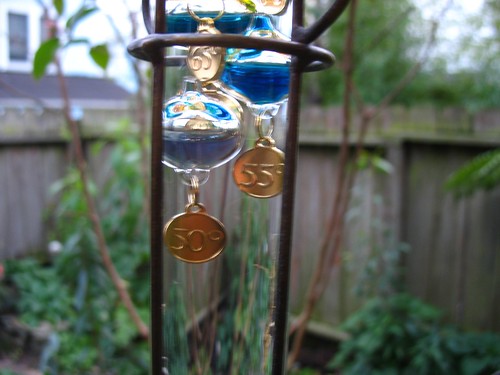
No lame, make-believe excuses for me. I can't say "oh dear, the ground is frozen" or "oh dear, there's an ice storm and I could die". No, it's just cold. And wet. I've recorded 4.1 inches of rain so far this year, and there's more coming tonight. In fact, there's nothing in the forecast but rain and temperatures in the low fifties.
I've been having some issues with death and destruction lately... I put out a saucer of beer to kill slugs and I got a caterpillar. That's too bad. But maybe it was a moth caterpillar.
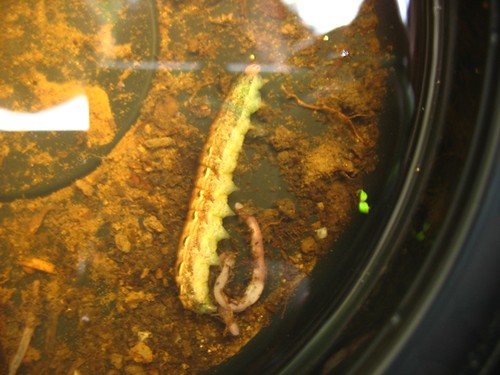
And I broke my shovel digging up the Brugmansia.
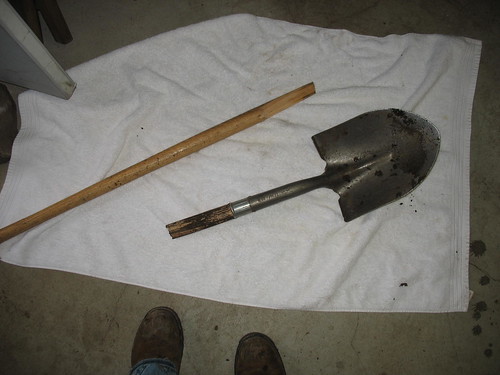
We bought this shovel in 2003, before I started gardening. Guy wanted bamboo in the backyard, and this was the shovel we planted it with. It's been a good shovel, but it's not really a gardener's shovel.
So I bought a new one. Say hello to my little friend.
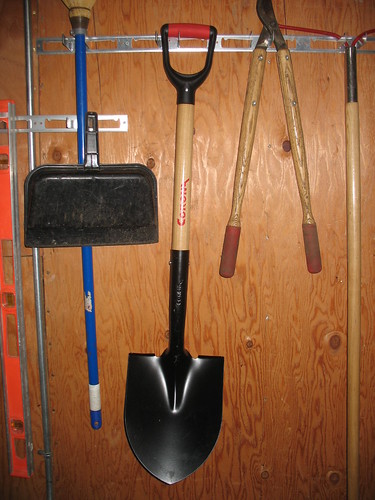
There were only two shovels to choose from at the nursery. It was kinda cheap, only $15, so I hope it lasts for awhile.
I'm preparing for the spring vegetable garden. Clearing out the carrots...
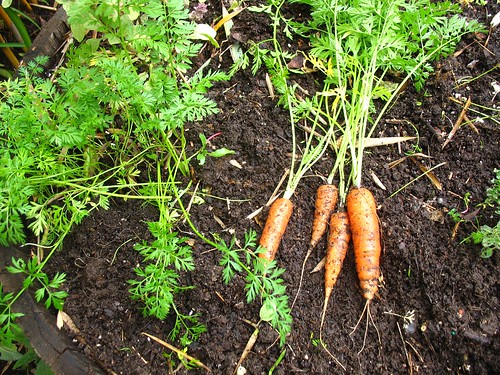
Then upon tasting them, changing my mind and deciding to plant some more. So sweet! Oh, well. Maybe I can get another crop out before the squash goes in in April. I left a few carrots to go to seed when the weather warms up. Carrot flowers are cute and attract beneficials, and like all good biennials, carrots self-sow.
I started a tee-pee for the snap peas. Two are ready to plant out, and I have several more in the garage, germinating.

I love snap peas, and I don't like snow peas at all. Did you know they grew snap peas hundreds of years ago, but lost them?
Pam Peirce:
(Nothing compares to forgetting how to make concrete for 13 centuries.)
I planted an apple tree where the Brugmansia used to be.

I went with this Striped Gravenstein from Raintree Nursery, grafted on their proprietary "mini-dwarfing" rootstock which should hold the plant to six feet tall.
And actually I bought two of them. The second one I planted in a raised bed where I have grand plans for a solar-powered recirculating water fountain.
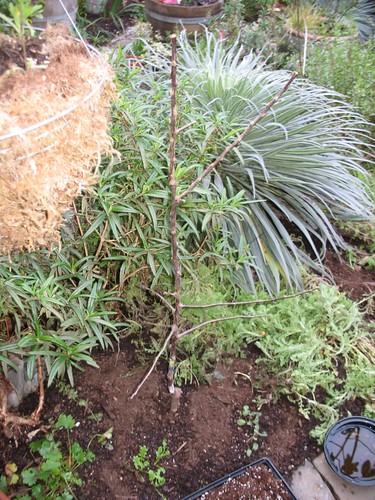
In order to plant the tree here and give it room, I had to expand the wall of the raised bed and bury a sprinkler head. I never turn on the sprinklers anyway. I turned the water off to them and unplugged the timer a long time ago.
Gravensteins need a pollenizer. They don't self-fruit, and they don't pollinate each other (they don't pollinate anything). My neighbor two doors down (about 40 feet away) has a huge apple tree in his backyard that flowers early, like the Gravenstein. Will it work? We shall see. Hopefully, it's not a Gravenstein too.
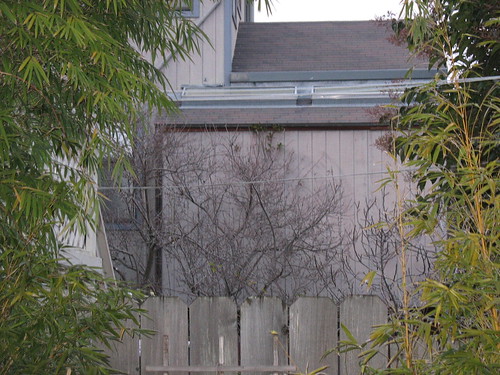
What else is going on? One other thing of note. There's a spider-web 11 feet up under my deck...
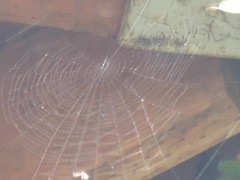

and the bottom of the web is anchored to the growing, grasping tendril of Cobaea scandens. I can only imagine the growing tendril slackens the web daily. Do you think the spider has to cinch it up?

No lame, make-believe excuses for me. I can't say "oh dear, the ground is frozen" or "oh dear, there's an ice storm and I could die". No, it's just cold. And wet. I've recorded 4.1 inches of rain so far this year, and there's more coming tonight. In fact, there's nothing in the forecast but rain and temperatures in the low fifties.
I've been having some issues with death and destruction lately... I put out a saucer of beer to kill slugs and I got a caterpillar. That's too bad. But maybe it was a moth caterpillar.

And I broke my shovel digging up the Brugmansia.

We bought this shovel in 2003, before I started gardening. Guy wanted bamboo in the backyard, and this was the shovel we planted it with. It's been a good shovel, but it's not really a gardener's shovel.
So I bought a new one. Say hello to my little friend.

There were only two shovels to choose from at the nursery. It was kinda cheap, only $15, so I hope it lasts for awhile.
I'm preparing for the spring vegetable garden. Clearing out the carrots...

Then upon tasting them, changing my mind and deciding to plant some more. So sweet! Oh, well. Maybe I can get another crop out before the squash goes in in April. I left a few carrots to go to seed when the weather warms up. Carrot flowers are cute and attract beneficials, and like all good biennials, carrots self-sow.
I started a tee-pee for the snap peas. Two are ready to plant out, and I have several more in the garage, germinating.

I love snap peas, and I don't like snow peas at all. Did you know they grew snap peas hundreds of years ago, but lost them?
Pam Peirce:
"Snap peas revolutionized pea growing several years ago, when a breeder discovered in his trial planting a pea plant bearing a thick, crisp, edible pods like those of a snap bean...
After the snap pea became popular, researchers discovered descriptions of just such peas in gardening books from a couple of centuries ago. Apparently, this is an example of an heirloom variety nearly lost but rediscovered by chance during a breeding program."
(Nothing compares to forgetting how to make concrete for 13 centuries.)
I planted an apple tree where the Brugmansia used to be.

I went with this Striped Gravenstein from Raintree Nursery, grafted on their proprietary "mini-dwarfing" rootstock which should hold the plant to six feet tall.
And actually I bought two of them. The second one I planted in a raised bed where I have grand plans for a solar-powered recirculating water fountain.

In order to plant the tree here and give it room, I had to expand the wall of the raised bed and bury a sprinkler head. I never turn on the sprinklers anyway. I turned the water off to them and unplugged the timer a long time ago.
Gravensteins need a pollenizer. They don't self-fruit, and they don't pollinate each other (they don't pollinate anything). My neighbor two doors down (about 40 feet away) has a huge apple tree in his backyard that flowers early, like the Gravenstein. Will it work? We shall see. Hopefully, it's not a Gravenstein too.

What else is going on? One other thing of note. There's a spider-web 11 feet up under my deck...


and the bottom of the web is anchored to the growing, grasping tendril of Cobaea scandens. I can only imagine the growing tendril slackens the web daily. Do you think the spider has to cinch it up?
1/18/08
UC Santa Cruz Arboretum

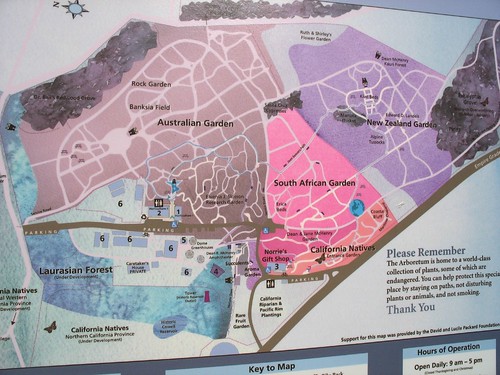
We've come to see the January Protaceae show, but first a short stop in California.
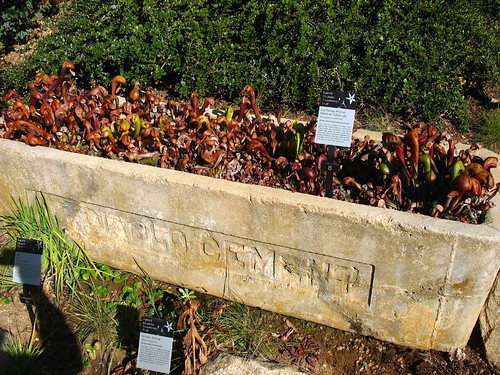
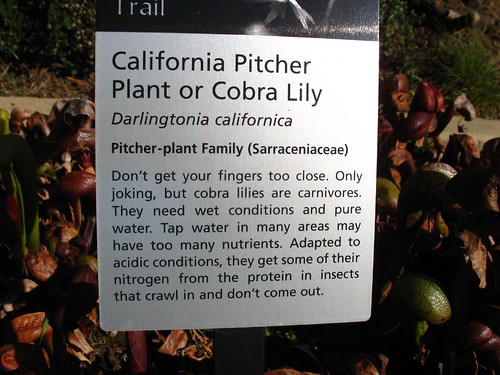
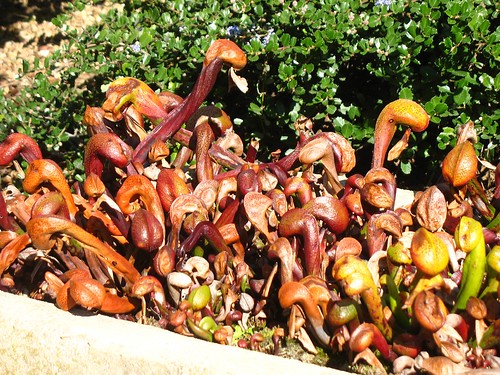
Despite recent rains, California still seems quite parched.
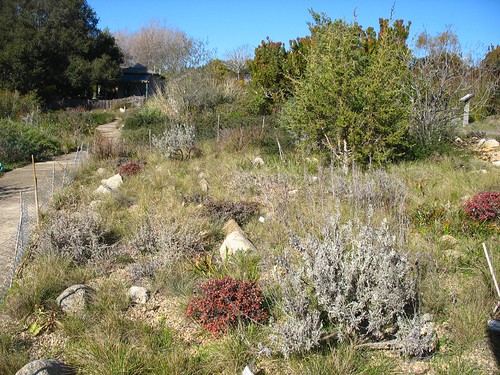
The fescues are greening up.
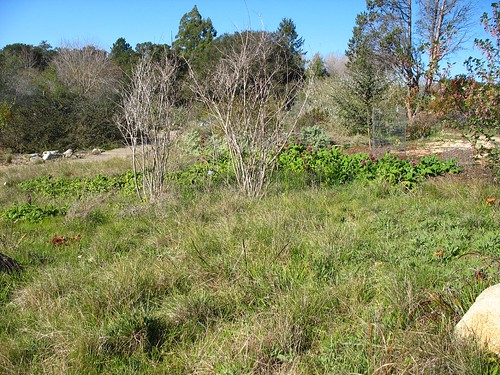
Salvia spathacea.
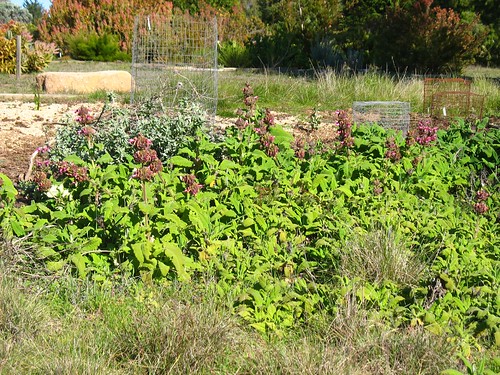
Penstemon.

A huge Artemisia behind this low wall.
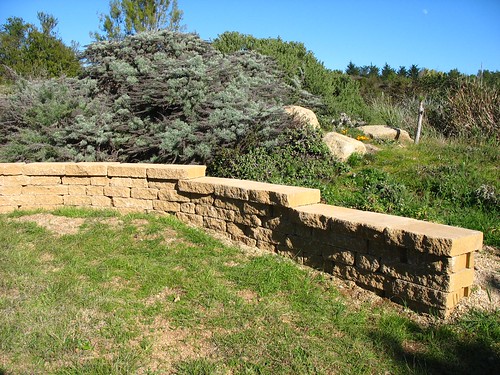
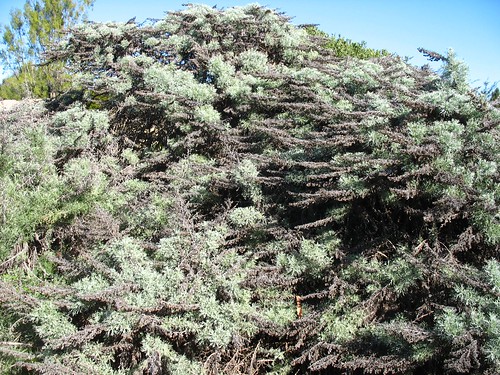
We like the simple wall.
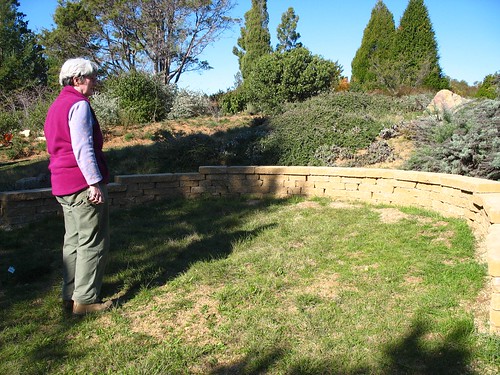
Another Eriogonum arborescens, with dead inflorescences I'm ready to snap off, but don't.
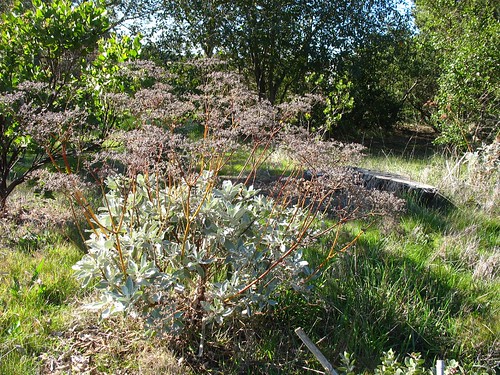
Ribes malvaceum. Why isn't mine flowering like this? Argh!
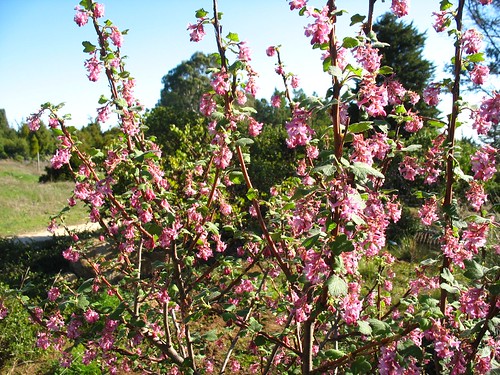

Hummingbird magnet.
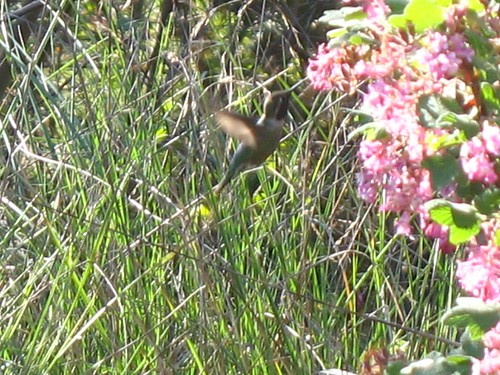
A pan on a cairn with some flowers. Simple, perfect.
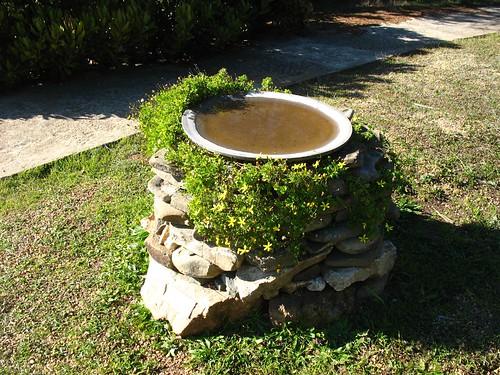
This botanical garden isn't like the others I frequent. There are no real garden beds, and you can walk right up to every plant and look it over quite thoroughly. There are some nice plant combinations (coming up!) but there is no landscape design here which might be in or out of style at some point down the road. It's nice.
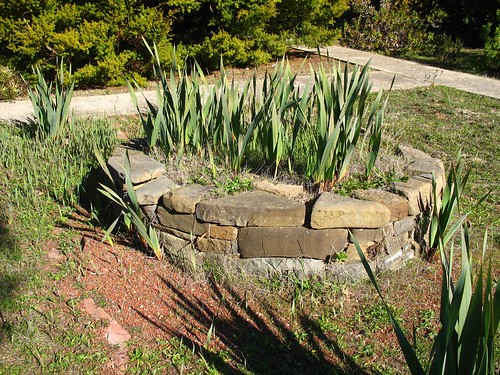
That's it for California.
The world has five mediterranean climate zones: the Mediterranenan, California, South Africa, south and west Australia, and Chile. South African landscapes like the one below are so distinct you can identify them at a distance with a quick glance.
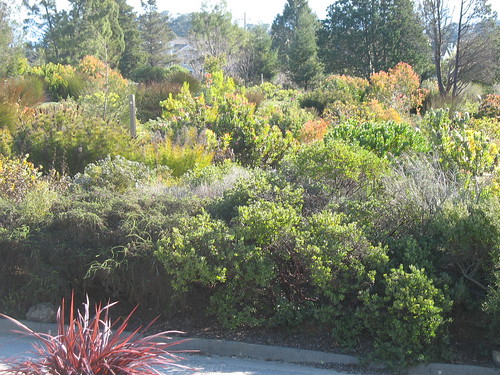
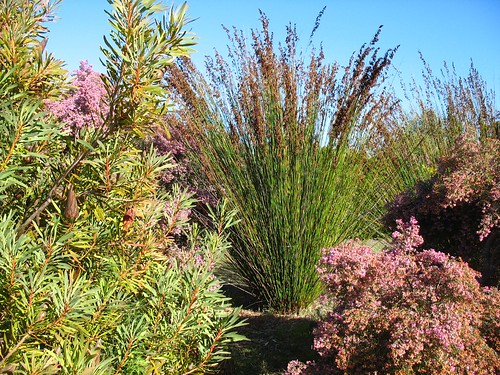
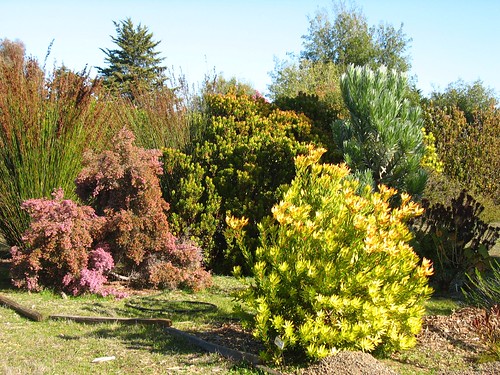
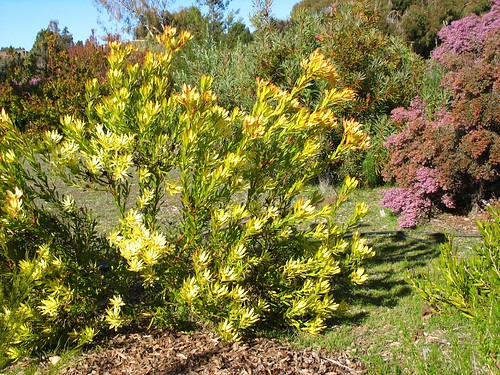
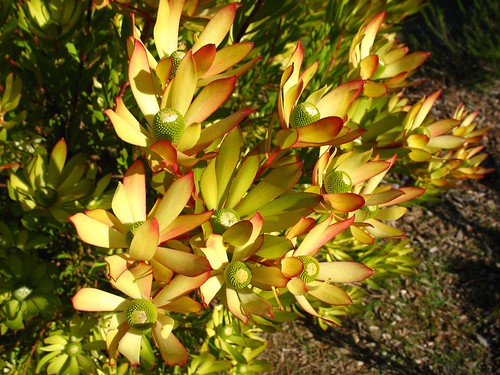

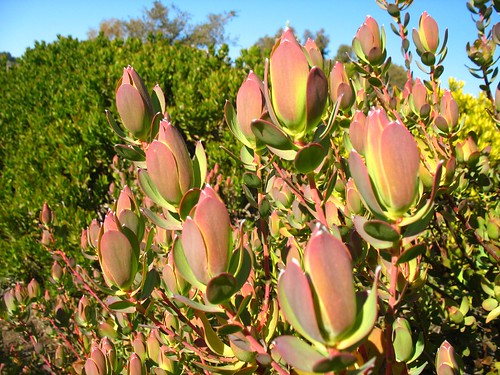
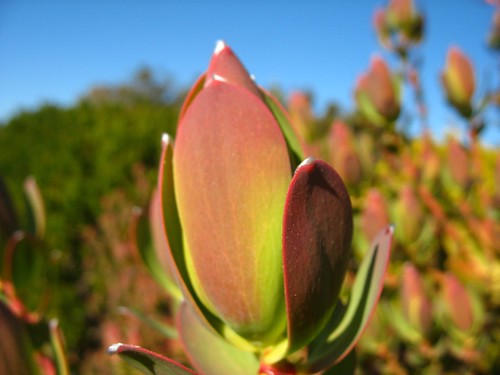
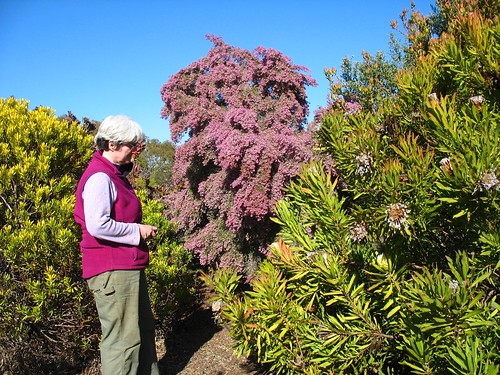
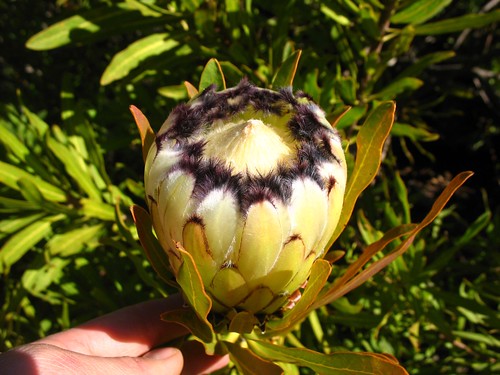


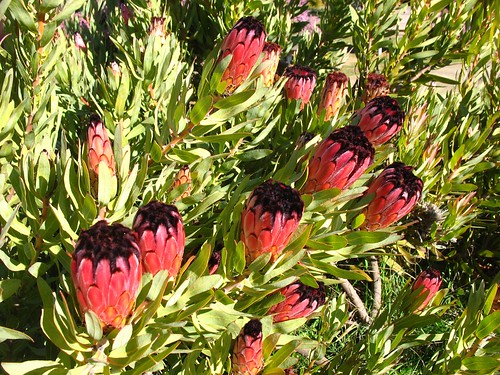
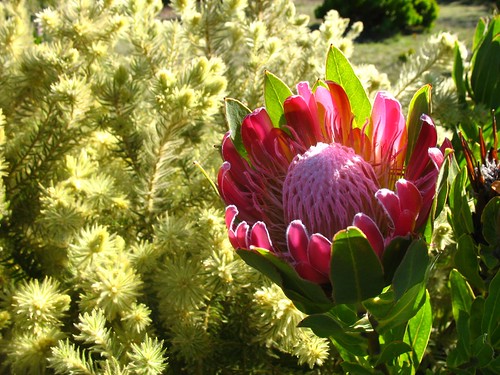
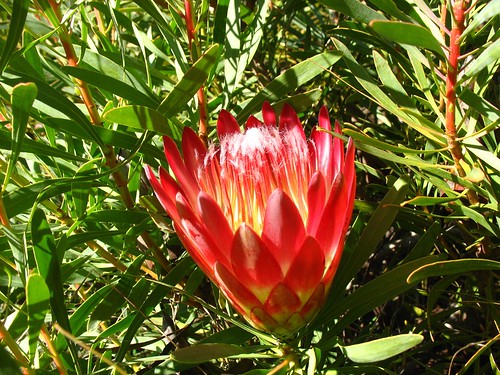
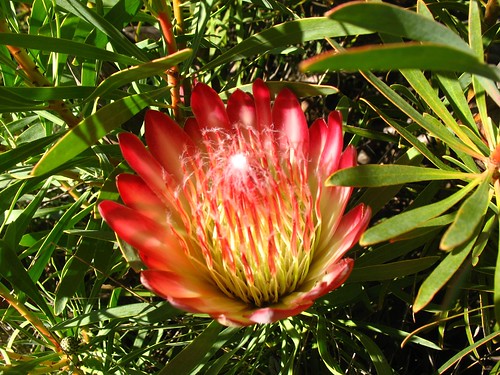

The bud.
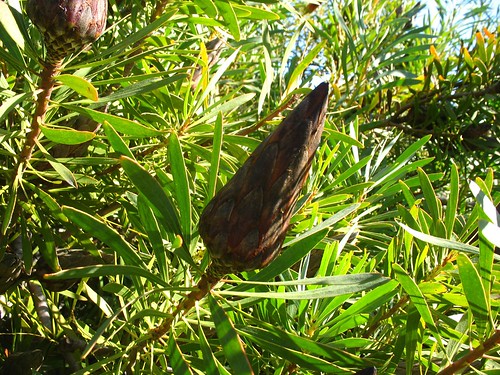
The dead head.
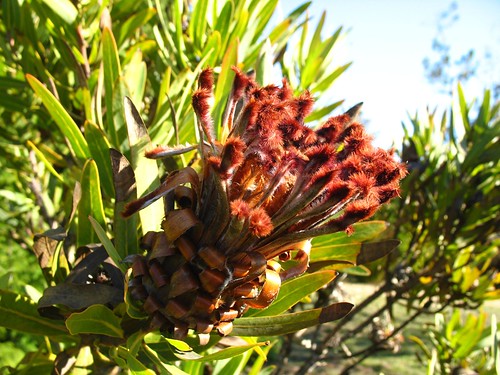
The thing about Protea sp., is that on older specimens, it's not uncommon for the trunk to split at the crown.
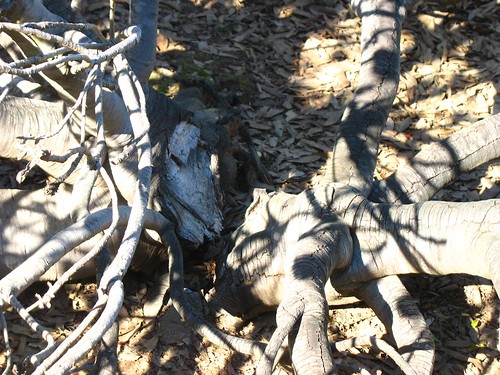
Then the both halves are toast.
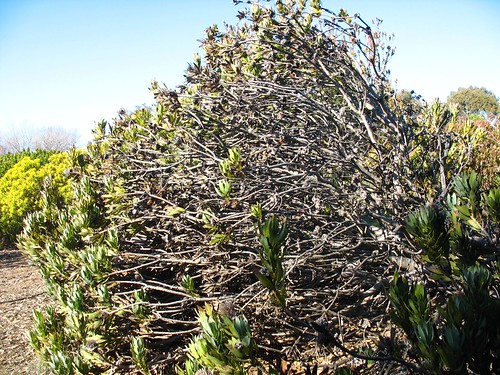
This happens at Strybing too.
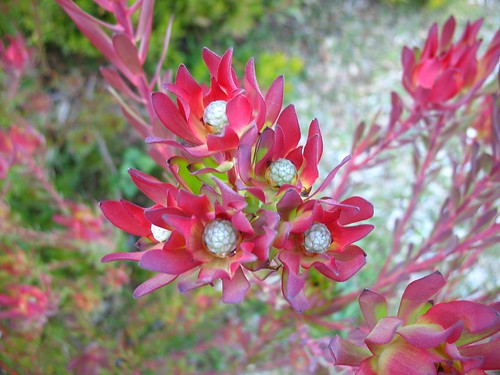
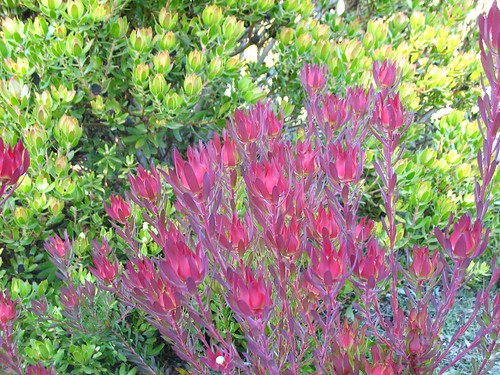
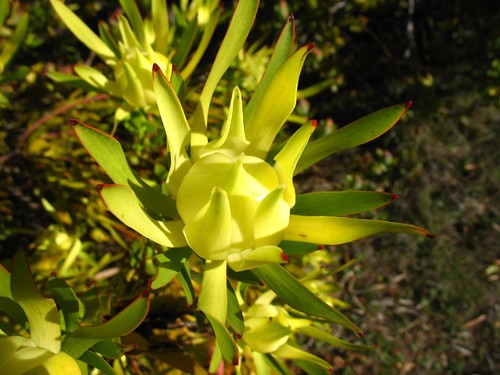
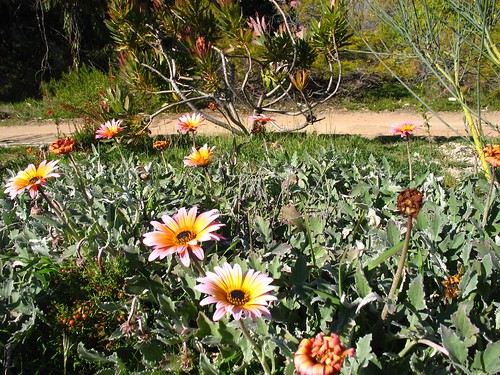
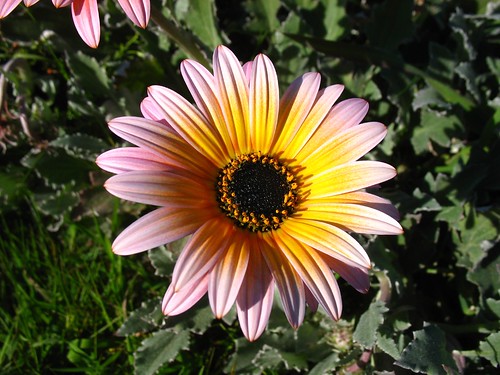
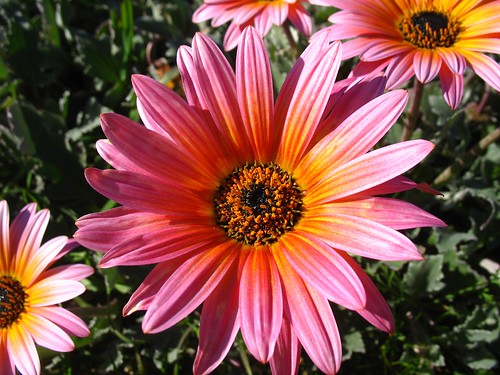
And now, moving in to Australia, Banksia.
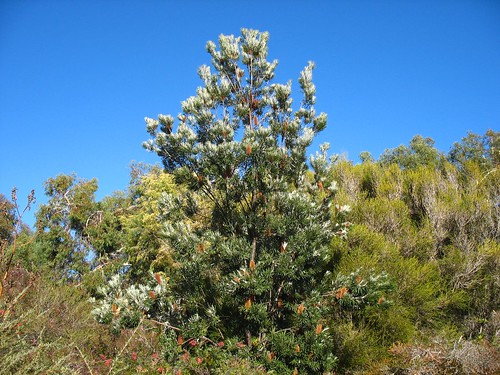
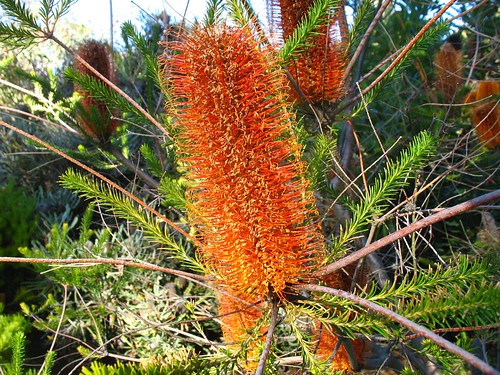
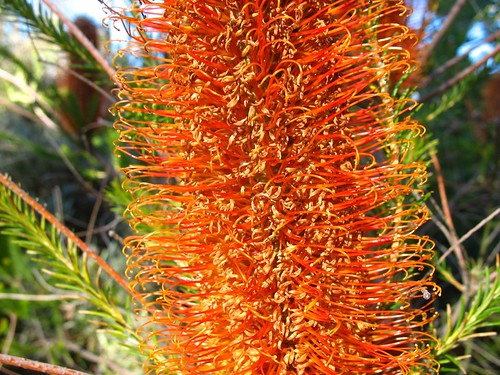
Hummingbirds love these.
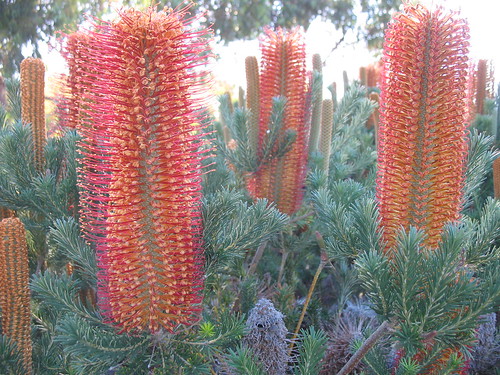
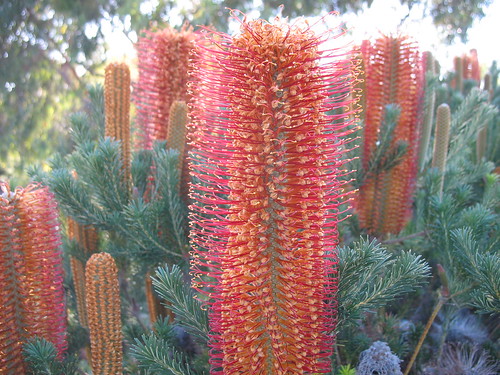
The fruit are crazy.

The fruit is a cone-like woody capsule that opens with heat. You can hold the "cone" over an open flame and these little mouths will open slowly and release the seed.
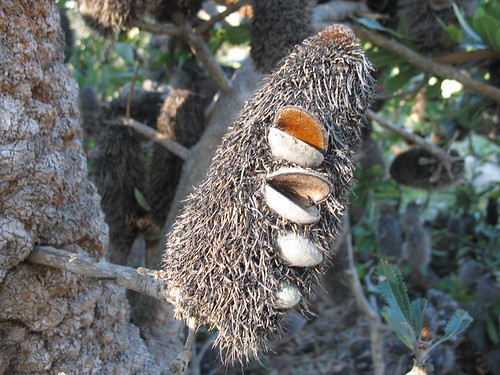
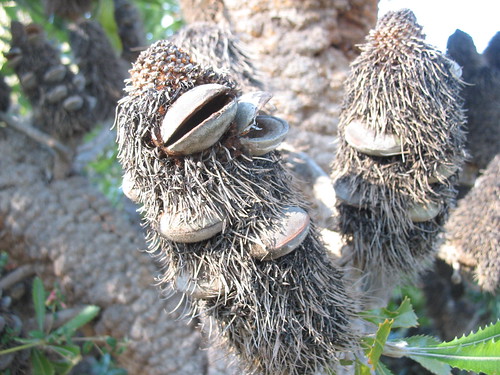
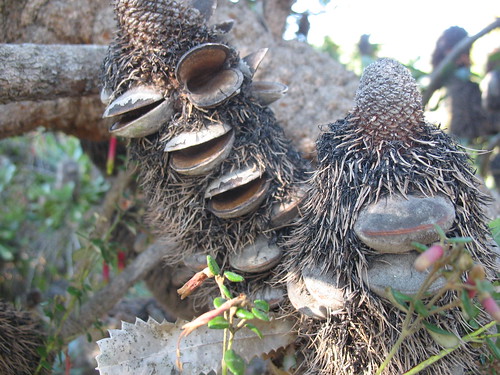
Banksia are shrubs, or 30-foot trees.

This picture is dark, but you can imagine having a tree full of the crazy cones.
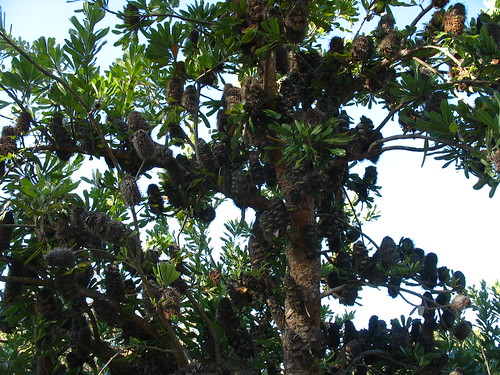
I like the wood too.
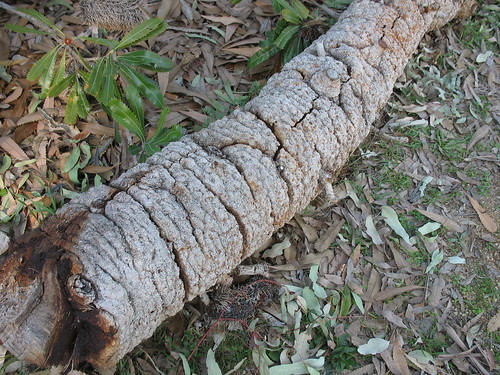
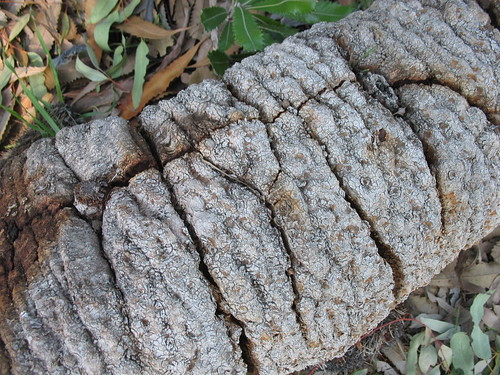

Soft and fuzzy.
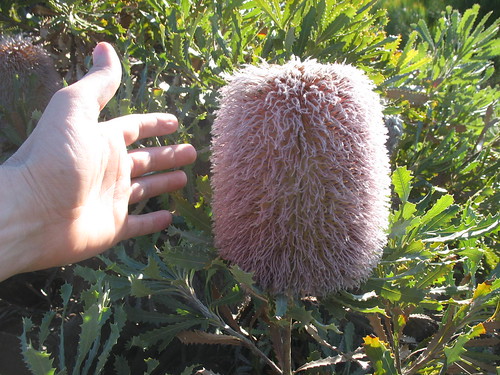
Grevillea.


The garden guru spies something in the rocks...
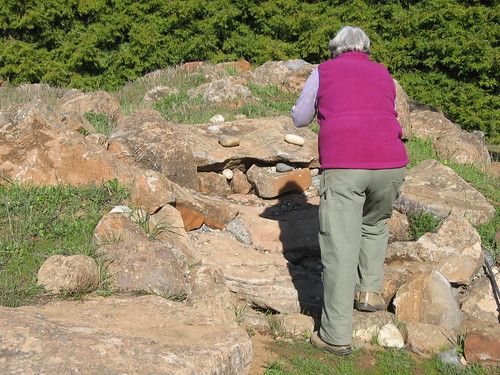
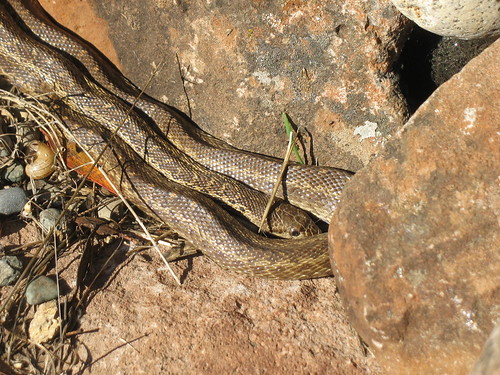
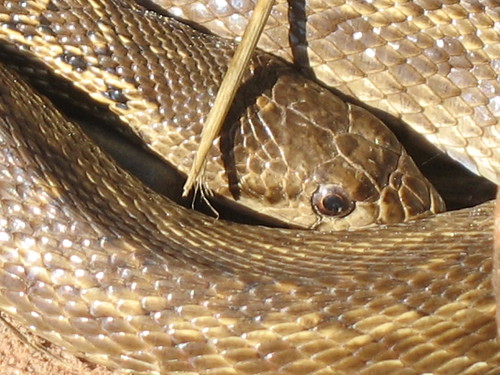
For you succulent lovers:
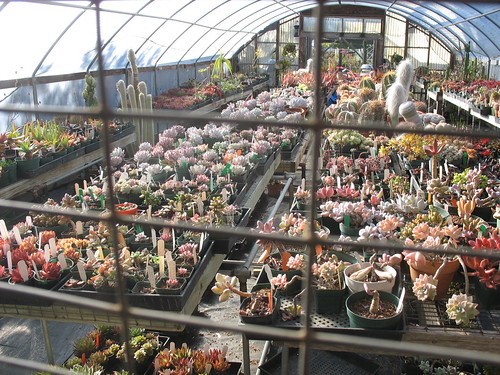
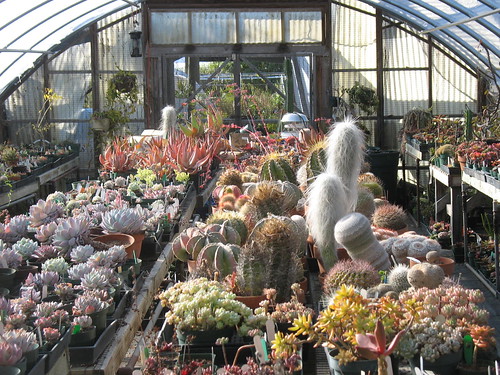
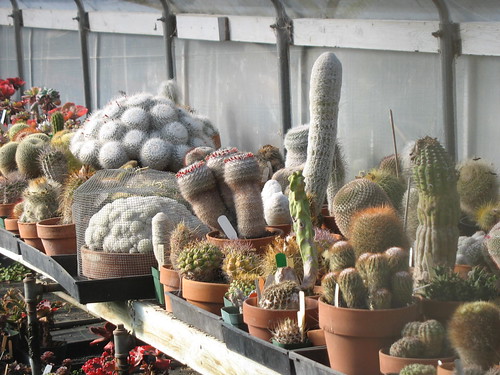
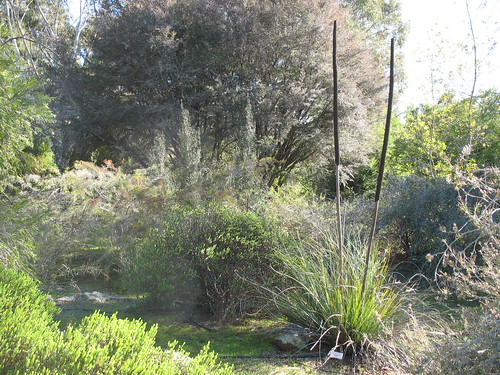
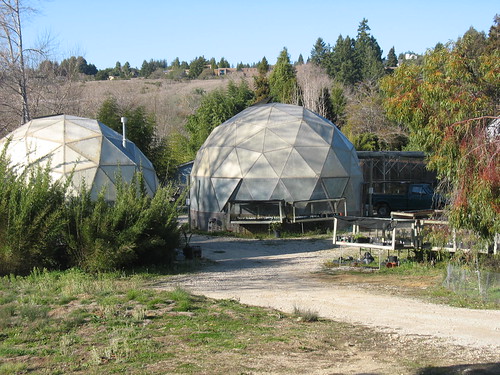
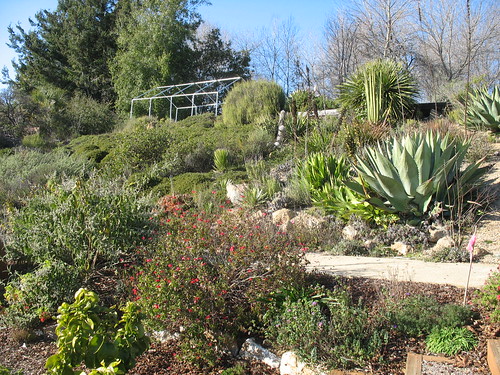
The fragrance garden abuts the cactus garden, and I think that's cool. A scented geranium (Pelargonium) in the foreground.
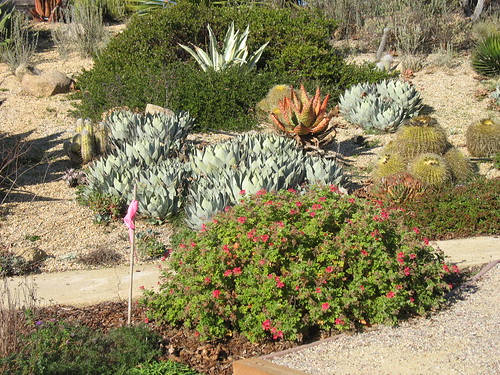
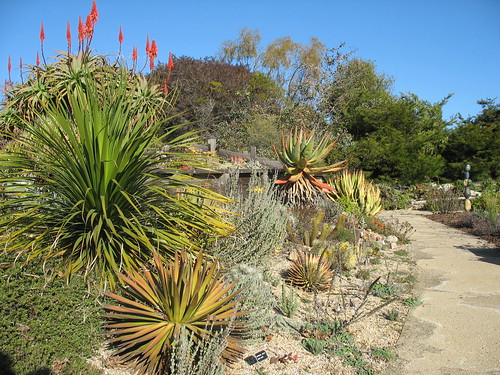


The sculpture is named Stack O' Seeds, by Doug Hennig.
I need to wrap up. Why not end with a sight more familiar to most readers...
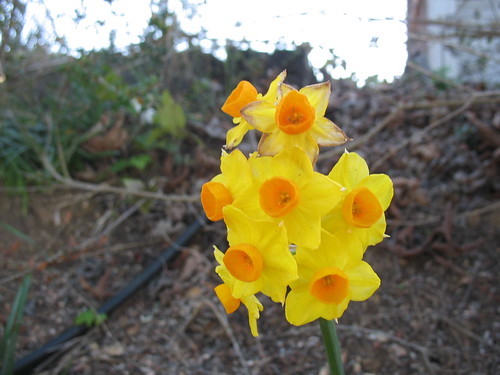
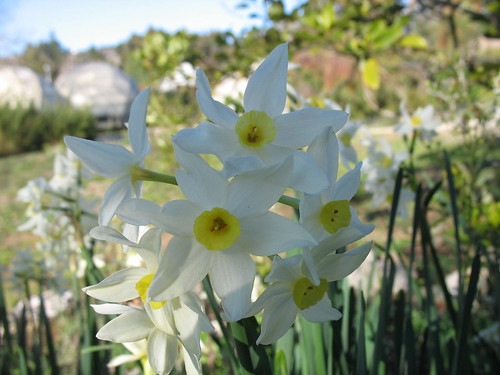
Subscribe to:
Comments (Atom)
